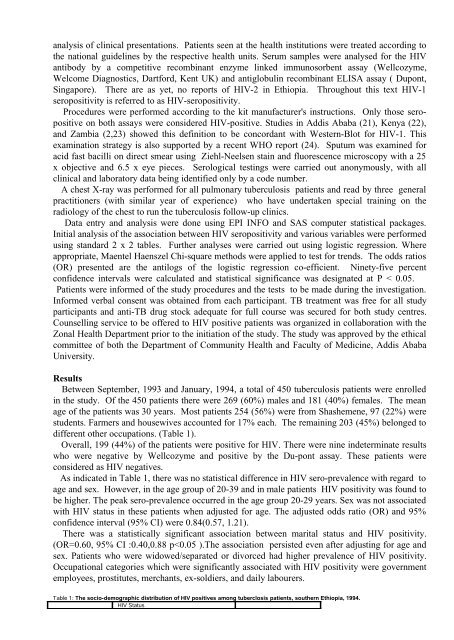Original article - Ethiopian Review
Original article - Ethiopian Review
Original article - Ethiopian Review
- No tags were found...
You also want an ePaper? Increase the reach of your titles
YUMPU automatically turns print PDFs into web optimized ePapers that Google loves.
analysis of clinical presentations. Patients seen at the health institutions were treated according tothe national guidelines by the respective health units. Serum samples were analysed for the HIVantibody by a competitive recombinant enzyme linked immunosorbent assay (Wellcozyme,Welcome Diagnostics, Dartford, Kent UK) and antiglobulin recombinant ELISA assay ( Dupont,Singapore). There are as yet, no reports of HIV-2 in Ethiopia. Throughout this text HIV-1seropositivity is referred to as HIV-seropositivity.Procedures were performed according to the kit manufacturer's instructions. Only those seropositiveon both assays were considered HIV-positive. Studies in Addis Ababa (21), Kenya (22),and Zambia (2,23) showed this definition to be concordant with Western-Blot for HIV-1. Thisexamination strategy is also supported by a recent WHO report (24). Sputum was examined foracid fast bacilli on direct smear using Ziehl-Neelsen stain and fluorescence microscopy with a 25x objective and 6.5 x eye pieces. Serological testings were carried out anonymously, with allclinical and laboratory data being identified only by a code number.A chest X-ray was performed for all pulmonary tuberculosis patients and read by three generalpractitioners (with similar year of experience) who have undertaken special training on theradiology of the chest to run the tuberculosis follow-up clinics.Data entry and analysis were done using EPI INFO and SAS computer statistical packages.Initial analysis of the association between HIV seropositivity and various variables were performedusing standard 2 x 2 tables. Further analyses were carried out using logistic regression. Whereappropriate, Maentel Haenszel Chi-square methods were applied to test for trends. The odds ratios(OR) presented are the antilogs of the logistic regression co-efficient. Ninety-five percentconfidence intervals were calculated and statistical significance was designated at P < 0.05.Patients were informed of the study procedures and the tests to be made during the investigation.Informed verbal consent was obtained from each participant. TB treatment was free for all studyparticipants and anti-TB drug stock adequate for full course was secured for both study centres.Counselling service to be offered to HIV positive patients was organized in collaboration with theZonal Health Department prior to the initiation of the study. The study was approved by the ethicalcommittee of both the Department of Community Health and Faculty of Medicine, Addis AbabaUniversity.ResultsBetween September, 1993 and January, 1994, a total of 450 tuberculosis patients were enrolledin the study. Of the 450 patients there were 269 (60%) males and 181 (40%) females. The meanage of the patients was 30 years. Most patients 254 (56%) were from Shashemene, 97 (22%) werestudents. Farmers and housewives accounted for 17% each. The remaining 203 (45%) belonged todifferent other occupations. (Table 1).Overall, 199 (44%) of the patients were positive for HIV. There were nine indeterminate resultswho were negative by Wellcozyme and positive by the Du-pont assay. These patients wereconsidered as HIV negatives.As indicated in Table 1, there was no statistical difference in HIV sero-prevalence with regard toage and sex. However, in the age group of 20-39 and in male patients HIV positivity was found tobe higher. The peak sero-prevalence occurred in the age group 20-29 years. Sex was not associatedwith HIV status in these patients when adjusted for age. The adjusted odds ratio (OR) and 95%confidence interval (95% CI) were 0.84(0.57, 1.21).There was a statistically significant association between marital status and HIV positivity.(OR=0.60, 95% CI :0.40,0.88 p




![to read the full report [pdf, Amharic] - Ethiopian Review](https://img.yumpu.com/52737829/1/190x245/to-read-the-full-report-pdf-amharic-ethiopian-review.jpg?quality=85)











